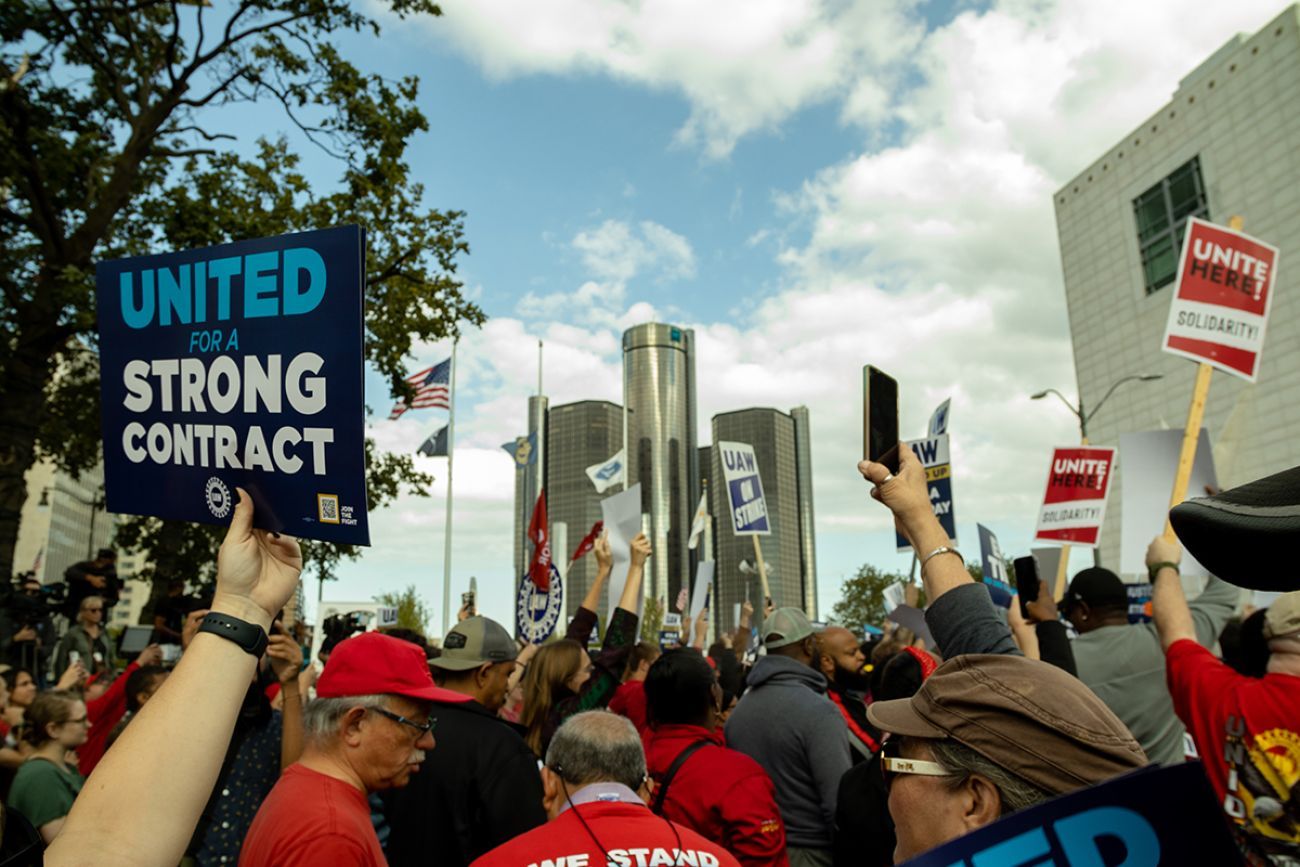UAW strike ends: Higher pay, more EV worries, tighter margins for Big Three

- The UAW deals leave the Big Three with a challenging financial balancing act as it competes with non-union rivals
- Hourly wages will increase as automakers cut back on EV-related spending
- Union workers fresh from the contract wins will remain a strong voting bloc in presidential elections.
Union Auto Workers members are headed back to work at the conclusion of a nearly seven-week strike that produced historic wage increases for union workers at the Big Three.
The union reached a tentative agreement with General Motors Corp. early Monday, following settlements days earlier with Stellantis and Ford Motor Co.
President Joe Biden called the deals a “hard-fought agreement” following weeks of “good faith” negotiations in remarks Monday afternoon, after talking with UAW President Shawn Fain.
Related:
- UAW-Ford deal hints at fine line Detroit Three must walk on labor costs
- UAW strike against the Big Three: A timeline of historic 2023 work action
- UAW strike 2023 updates
- UAW strike impact grows in Michigan as walkouts enter second month
With negotiations done, roughly 145,000 UAW members at the Big Three are soon likely to be covered by a more lucrative 4.5-year contract that provides at least 25 percent raises.
“The UAW was stunningly successful in achieving every one of their major objectives in these tentative agreements,” said Patrick Anderson, CEO of Anderson Economic Group in East Lansing.

Strike demands included not just wage hikes and an end to pay tiers, but also that automakers find a place for union workers in new and in-development EV battery factories.
UAW tactics during what the union called its stand-up strike “had the effect of constantly keeping the automakers off guard, striking plants with only hours notice and escalating the cost to the automakers and their suppliers,” Anderson said.
At the same time, the union minimized how many of their workers were on strike, Anderson added.
Automakers, meanwhile, are left to contemplate how higher labor costs will impact balance sheets and production strategies as they confront heavy losses in EV sales, slow their EV investments and try to compete with non-union companies such as Tesla on EVs.
Here are three things Michigan learned from the strike:
EVs have Detroit automakers in a financial fix
The UAW had leverage in its push for record contracts given record profits at the Detroit automakers.
But most of those profits come from bigger, internal combustion SUVs, even as the industry is transitioning to electric vehicles. At Ford, for instance, company revenue in the third quarter grew 11 percent to $43.8 billion, but its electric vehicle division lost $1.3 billion.
GM, Ford and other automakers have set aggressive EV production targets, but the market for electric vehicles, while increasing, is not keeping pace with the production pace.
Michigan expects a combined 9,200 new jobs from five new or expanded EV battery factories in the state. Yet the mismatch to the market is upending profitability projections at GM and Ford, in particular, stalling the automakers’ investments of billions of dollars in new EV-centered facilities.
One Michigan-centered effect of the move is that GM recently said it will extend the time it will take to complete its Orion Township factory upgrades, where EVs will be built.
Ford, meanwhile, has tapped the brakes on its $3.5 billion EV battery factory planned in Marshall among $12 billion in paused projects.
GM so far hasn’t halted plans at the Delta Township Ultium Cells EV battery factory the company is building next to its west Lansing area assembly and stamping plants. That Michigan factory is the third of four EV battery facilities by GM and partner Samsung, along with factories in Lordstown, Ohio and Spring Hill, Tennessee. The new Delta Township plant is expected to open in 2024.
“We'll keep all of those on track because we believe strongly that we need those cells,” GM CEO Mary Barra told analysts last Tuesday. “Now, obviously, if we have to evaluate and slow something down (we will), but at this time we don't see a need to do that.”
GM also stopped its partnership with Honda last week, ending a deal for the Japanese automaker to produce lower-cost EVs that would use the Ultium battery cell.
In a call with analysts, GM said it planned to cut $2 billion in fixed costs over two years. So far, those cuts include 5,000 white-collar jobs, after the automaker offered buyouts to 35,000 workers — many in Michigan — early this year.
Historic wage increases
The UAW won 25-percent increases for top tier workers on wages that were already higher than those paid by automakers with non-union factory workers, including Tesla. The Big Three said during the strike they feared they would not be able to compete with non-union companies if they gave in too much on union wage demands.
Tesla spends about $45 an hour on production labor for wages and benefits, while Ford, GM and Stellantis spend about $66 per hour under the current contract— a figure that has also included wage tiers, with workers hired since 2007 starting and topping out at lower wages.
Legacy workers currently earn up to $32.32 per hour. The new, tentative contracts mean most UAW workers will earn over $40 per hour (or $83,200 per year before overtime). Tesla production workers start at around $20 per hour ($41,600.)
The strike highlighted industry reliance on second-tier and temporary workers who make far less. The tentative contracts would eliminate tiers and allow workers to reach full pay within three years instead of eight. Temporary workers also have a much clearer and shorter path to becoming full-time workers, according to reports.
The agreements place additional competitive pressures on Michigan’s companies and the state, said Sandy Baruah, president and CEO of the Detroit Regional Chamber.
“These agreements will increase the cost of vehicles made by UAW workers by hundreds, even $1,000, and make competing companies' offerings more attractive,” Baruah said in a statement. “Michigan will have to work overtime to send the message that it is open for business.”
The UAW enjoyed broad public support during the strike, given that factory wages have stagnated as CEO salaries exploded.
Barra, the GM CEO, made $28 million last year — 362 times the average employee’s wage — and more than 10 times what Daniel Akerson made in 2010 when he was GM’s CEO.
A decisive voting bloc
About 66,000 state workers are under UAW contracts with the domestic automakers, representing about 1.3 percent of Michigan’s workforce.
Their impact is bigger than their numbers. They are organized. They represent an enduring image of Michigan’s manufacturing middle class, so their wage fight has served as a useful proxy for whether the state’s economy works for “real people.” And the auto industry still dominates the state economy.
So was it any surprise that Biden became the first president to walk a picket line, when he addressed striking workers in Belleville in September? Or that former President Donald Trump wooed the UAW rank-and-file with a speech in Macomb County?
Biden carried Michigan by 150,000 votes in 2020. A prospective rematch is expected to hit on themes that resonated during the strike, and factory workers could play a decisive role.
Biden’s reward for his UAW support may have been the ability to announce the tentative deal with GM.
Gov. Gretchen Whitmer also congratulated the union Monday, saying she hopes UAW members will quickly ratify the deals. That could take weeks.
News of the tentative deals was not boosting stock prices.
On Friday, GM [NYSE: GM] stock closed Friday at $27.22, giving it a market capitalization of about $37.2 billion — about a 22 percent drop, or loss of $10.6 billion — from year-end 2022.
Ford [NYSE: F] stock fell 12 percent on Friday, then fell another 2 percent on Monday, dropping to $9.77 per share and a market cap of $39.9 billion — a $6 billion loss from year-end 2022.
Business Watch
Covering the intersection of business and policy, and informing Michigan employers and workers on the long road back from coronavirus.
- About Business Watch
- Subscribe
- Share tips and questions with Bridge Business Editor Paula Gardner
Thanks to our Business Watch sponsors.
Support Bridge's nonprofit civic journalism. Donate today.
See what new members are saying about why they donated to Bridge Michigan:
- “In order for this information to be accurate and unbiased it must be underwritten by its readers, not by special interests.” - Larry S.
- “Not many other media sources report on the topics Bridge does.” - Susan B.
- “Your journalism is outstanding and rare these days.” - Mark S.
If you want to ensure the future of nonpartisan, nonprofit Michigan journalism, please become a member today. You, too, will be asked why you donated and maybe we'll feature your quote next time!




